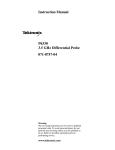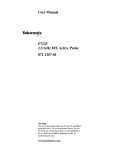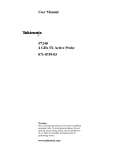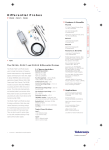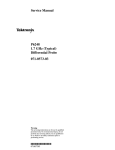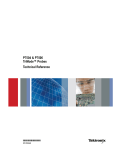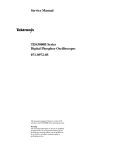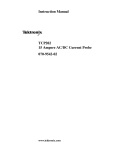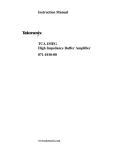Download P7330 3.5 GHz Differential Probe User Manual
Transcript
® E stablished 1981 Advanced Test Equipment Rentals www.atecorp.com 800-404-ATEC (2832) User Manual P7330 3.5 GHz Differential Probe 071-0758-04 Warning The servicing instructions are for use by qualified personnel only. To avoid personal injury, do not perform any servicing unless you are qualified to do so. Refer to all safety summaries prior to performing service. www.tektronix.com Copyright © Tektronix, Inc. All rights reserved. Tektronix products are covered by U.S. and foreign patents, issued and pending. Information in this publication supercedes that in all previously published material. Specifications and price change privileges reserved. Tektronix, Inc., P.O. Box 500, Beaverton, OR 97077 TEKTRONIX, TEK, SureFoot, and TekConnect are registered trademarks of Tektronix, Inc., and KlipChip is a trademark of Tektronix, Inc. WARRANTY Tektronix warrants that the products that it manufactures and sells will be free from defects in materials and workmanship for a period of one (1) year from the date of shipment. If a product proves defective during this warranty period, Tektronix, at its option, either will repair the defective product without charge for parts and labor, or will provide a replacement in exchange for the defective product. In order to obtain service under this warranty, Customer must notify Tektronix of the defect before the expiration of the warranty period and make suitable arrangements for the performance of service. Customer shall be responsible for packaging and shipping the defective product to the service center designated by Tektronix, with shipping charges prepaid. Tektronix shall pay for the return of the product to Customer if the shipment is to a location within the country in which the Tektronix service center is located. Customer shall be responsible for paying all shipping charges, duties, taxes, and any other charges for products returned to any other locations. This warranty shall not apply to any defect, failure or damage caused by improper use or improper or inadequate maintenance and care. Tektronix shall not be obligated to furnish service under this warranty a) to repair damage resulting from attempts by personnel other than Tektronix representatives to install, repair or service the product; b) to repair damage resulting from improper use or connection to incompatible equipment; c) to repair any damage or malfunction caused by the use of non-Tektronix supplies; or d) to service a product that has been modified or integrated with other products when the effect of such modification or integration increases the time or difficulty of servicing the product. THIS WARRANTY IS GIVEN BY TEKTRONIX IN LIEU OF ANY OTHER WARRANTIES, EXPRESS OR IMPLIED. TEKTRONIX AND ITS VENDORS DISCLAIM ANY IMPLIED WARRANTIES OF MERCHANTABILITY OR FITNESS FOR A PARTICULAR PURPOSE. TEKTRONIX’ RESPONSIBILITY TO REPAIR OR REPLACE DEFECTIVE PRODUCTS IS THE SOLE AND EXCLUSIVE REMEDY PROVIDED TO THE CUSTOMER FOR BREACH OF THIS WARRANTY. TEKTRONIX AND ITS VENDORS WILL NOT BE LIABLE FOR ANY INDIRECT, SPECIAL, INCIDENTAL, OR CONSEQUENTIAL DAMAGES IRRESPECTIVE OF WHETHER TEKTRONIX OR THE VENDOR HAS ADVANCE NOTICE OF THE POSSIBILITY OF SUCH DAMAGES. Preface This is the User Manual for the P7330 differential probe. This manual provides operating information, specifications, and a replaceable parts list. Related Manuals If you need to do a performance verification or make internal adjustments to your probe, refer to the P7330 3.5 GHz Differential Probe Service Manual, Tektronix part number 071-1057-XX. The manual is a printable pdf file, and is available on both the Tektronix website and the Optional Applications CD that is included with Tektronix oscilloscopes featuring the TekConnect interface. P7330 3.5 GHz Differential Probe User Manual i Preface Contacting Tektronix Phone 1-800-833-9200* Address Tektronix, Inc. Department or name (if known) 14200 SW Karl Braun Drive P.O. Box 500 Beaverton, OR 97077 USA Web site www.tektronix.com Sales support 1-800-833-9200, select option 1* Service support 1-800-833-9200, select option 2* Technical support Email: [email protected] 1-800-833-9200, select option 3* 6:00 a.m. - 5:00 p.m. Pacific time * ii This phone number is toll free in North America. After office hours, please leave a voice mail message. Outside North America, contact a Tektronix sales office or distributor; see the Tektronix web site for a list of offices. P7330 3.5 GHz Differential Probe User Manual Table of Contents General Safety Summary . . . . . . . . . . . . . . . . . . . . . . . . . . . . iii Preface . . . . . . . . . . . . . . . . . . . . . . . . . . . . . . . . . . . . . . . . . . . . Related Manuals . . . . . . . . . . . . . . . . . . . . . . . . . . . . . . . . . . . . Contacting Tektronix . . . . . . . . . . . . . . . . . . . . . . . . . . . . . . . . . v v vi Getting Started . . . . . . . . . . . . . . . . . . . . . . . . . . . . . . . . . . . . . TekConnect Interface . . . . . . . . . . . . . . . . . . . . . . . . . . . . . . . . . Functional Check . . . . . . . . . . . . . . . . . . . . . . . . . . . . . . . . . . . . Options . . . . . . . . . . . . . . . . . . . . . . . . . . . . . . . . . . . . . . . . . . . . Features and Standard Accessories . . . . . . . . . . . . . . . . . . . . . . Optional Accessories . . . . . . . . . . . . . . . . . . . . . . . . . . . . . . . . . 1 1 3 4 5 9 Operating Basics . . . . . . . . . . . . . . . . . . . . . . . . . . . . . . . . . . . Input Voltage Limits . . . . . . . . . . . . . . . . . . . . . . . . . . . . . . . . . Maximum Input Voltage . . . . . . . . . . . . . . . . . . . . . . . . . . . . . . Common-Mode Signal Range . . . . . . . . . . . . . . . . . . . . . . . . . . Differential-Mode Signal Range . . . . . . . . . . . . . . . . . . . . . . . . Common-Mode Rejection . . . . . . . . . . . . . . . . . . . . . . . . . . . . . Probing Techniques to Maximize CMRR . . . . . . . . . . . . . . . . . Input Impedance and Probe Loading . . . . . . . . . . . . . . . . . . . . . Probe Grounding . . . . . . . . . . . . . . . . . . . . . . . . . . . . . . . . . . . . Electrical Effects of Accessories . . . . . . . . . . . . . . . . . . . . . . . . 11 12 12 12 12 12 13 14 15 16 Reference . . . . . . . . . . . . . . . . . . . . . . . . . . . . . . . . . . . . . . . . . Problems with Single-Ended Measurements . . . . . . . . . . . . . . . Differential Measurements . . . . . . . . . . . . . . . . . . . . . . . . . . . . Common-Mode Rejection Ratio . . . . . . . . . . . . . . . . . . . . . . . . Assessing CMRR Error . . . . . . . . . . . . . . . . . . . . . . . . . . . . . . . Input Impedance Effects on CMRR . . . . . . . . . . . . . . . . . . . . . Extending the Input Leads . . . . . . . . . . . . . . . . . . . . . . . . . . . . . Extending the Ground Lead . . . . . . . . . . . . . . . . . . . . . . . . . . . . 17 17 17 18 18 19 19 20 Appendix A: Specifications . . . . . . . . . . . . . . . . . . . . . . . . . . . 21 Appendix B: User Service . . . . . . . . . . . . . . . . . . . . . . . . . . . . 27 Appendix C: Replaceable Parts . . . . . . . . . . . . . . . . . . . . . . . 29 P7330 3.5 GHz Differential Probe User Manual iii Table of Contents List of Figures Figure 1: P7330 differential probe featuring the TekConnect Interface . . . . . . . . . . . . . . . . . . . . . . . . . . . . . . Figure 2: Connecting and disconnecting the probe . . . . . . . . . . Figure 3: Probe functional check connections . . . . . . . . . . . . . Figure 4: Protect the probe tips with the protective cover . . . . Figure 5: Using the variable spacing adapter . . . . . . . . . . . . . . Figure 6: Using the TwinFoot adapter . . . . . . . . . . . . . . . . . . . . Figure 7: Typical probe input model . . . . . . . . . . . . . . . . . . . . . Figure 8: Probe ground input . . . . . . . . . . . . . . . . . . . . . . . . . . . Figure 9: Typical effects on a signal using probe tip adapters . Figure 10: Simplified model of a differential amplifier . . . . . . Figure 11: Twisting the input leads . . . . . . . . . . . . . . . . . . . . . . Figure 12: Typical common-mode gain . . . . . . . . . . . . . . . . . . Figure 13: Typical differential input impedance vs frequency . Figure 14: Probe head and compensation box dimensions . . . . Figure 15: P7330 replaceable parts . . . . . . . . . . . . . . . . . . . . . . Figure 16: P7330 standard accessories . . . . . . . . . . . . . . . . . . . Figure 17: P7330 optional accessories . . . . . . . . . . . . . . . . . . . iv 1 2 3 11 13 13 14 15 16 18 20 24 24 25 31 33 35 P7330 3.5 GHz Differential Probe User Manual General Safety Summary Review the following safety precautions to avoid injury and prevent damage to this product or any products connected to it. To avoid potential hazards, use this product only as specified. To Avoid Fire or Personal Injury Connect and Disconnect Properly. Connect the probe output to the measurement instrument before connecting the probe to the circuit under test. Disconnect the probe input and the probe ground from the circuit under test before disconnecting the probe from the measurement instrument. Observe All Terminal Ratings. To avoid fire or shock hazard, observe all ratings and markings on the product. Consult the product manual for further ratings information before making connections to the product. The common terminal is at ground potential. Do not connect the common terminal to elevated voltages. Do Not Operate Without Covers. Do not operate this product with covers or panels removed. Do Not Operate With Suspected Failures. If you suspect there is damage to this product, have it inspected by qualified service personnel. Do Not Operate in Wet/Damp Conditions. Do Not Operate in an Explosive Atmosphere. Keep Product Surfaces Clean and Dry. P7330 3.5 GHz Differential Probe User Manual v General Safety Summary Safety Terms and Symbols Terms in This Manual. These terms may appear in this manual: WARNING. Warning statements identify conditions or practices that could result in injury or loss of life. CAUTION. Caution statements identify conditions or practices that could result in damage to this product or other property. Terms on the Product. These terms may appear on the product: DANGER indicates an injury hazard immediately accessible as you read the marking. WARNING indicates an injury hazard not immediately accessible as you read the marking. CAUTION indicates a hazard to property including the product. Symbols on the Product. These symbols may appear on the product: CAUTION Refer to Manual vi P7330 3.5 GHz Differential Probe User Manual Getting Started The P7330 is a high-bandwidth (3.5 GHz) active differential probe with a miniaturized probe head design. The probe has low circuit loading, high common-mode rejection, and comes with a variety of accessories for connecting to surface-mount devices and other components. Figure 1: P7330 differential probe featuring the TekConnect Interface TekConnect Interface The P7330 probe is powered through a TekConnect Interface between the probe compensation box and the oscilloscope. The TekConnect Interface provides a communication path through contact pins on the host instrument. Power, signal, offset, and probe characteristic data transfer through the interface. P7330 3.5 GHz Differential Probe User Manual 1 Getting Started When the probe is connected, the oscilloscope reads EEPROM information from the probe, identifying the device and allowing the appropriate power supplies to be turned on. The preamp inputs on the oscilloscope are ESD protected by remaining grounded until a valid TekConnect device is detected. The TekConnect Interface features a spring-loaded latch that provides audible and tactile confirmation that a reliable connection has been made to the oscilloscope. Slide the probe into the TekConnect receptacle on the oscilloscope. The probe snaps into the oscilloscope when fully engaged. See Figure 2. To release the probe from the oscilloscope, grasp the compensation box, press the latch button, and pull out the probe. Latch button Figure 2: Connecting and disconnecting the probe 2 P7330 3.5 GHz Differential Probe User Manual Getting Started Functional Check After installing the probe on the oscilloscope, a functional check may be performed using the PROBE COMPENSATION connections on the front panel of the oscilloscope. See Figure 3. Figure 3: Probe functional check connections 1. Connect the probe to the oscilloscope. 2. Set the oscilloscope to display the probe channel. 3. Connect the square pin adapter to the probe tip, and connect the Y-lead adapter to the square pin adapter. Plug the SMT KlipChips into the Y-lead adapter. 4. Connect the SMT KlipChips to the PROBE COMPENSATION connections on the oscilloscope. 5. Adjust the oscilloscope to display a stable calibration waveform. P7330 3.5 GHz Differential Probe User Manual 3 Getting Started NOTE. If your instrument supports probe calibration routines, now is a good time to perform them. 6. Disconnect the probe from the PROBE COMPENSATION connector and connect the two KlipChips together. 7. With the probe offset set to 0.0 V, the oscilloscope display should be at the ground reference. 8. Set the oscilloscope volts/division to 500 mV. 9. Adjust the probe offset. The displayed waveform should vary between approximately +1.0 V and - 1.0 V. Options The following options are available when ordering the P7330 probe: H Option D1 - Calibration Data H Option C3 - 3 years Calibration Service H Option D3 - 3 years Calibration Data (requires Option C3) H Option R3 - 3 years Extended Warranty 4 P7330 3.5 GHz Differential Probe User Manual Getting Started Features and Standard Accessories Table 1 shows the features and standard accessories of the P7330 differential probe. Table 1: P7330 features and standard accessories Feature/Accessory Description TekConnect Interface. The TekConnect Interface provides a communication path between the probe and the oscilloscope. Contact pins provide power, signal, offset, and probe characteristic data transfer. The probe snaps into the oscilloscope when fully engaged. To remove, grasp the compensation box, press the latch button, and pull the probe out. Input connections. The plus and minus connections on the probe tip accept the standard and optional probe accessories. (Some of the accessories connect to the probe tip through the square pin adapter). The ground lead connects to the probe head through a slot in the side of the insulated probe housing. + - Ground WARNING: Skin penetration hazard. To prevent injury, install the probe tip cover when the probe is not in use. The probe tips are extremely sharp to ensure good contact and measurement integrity. Probe tip cover. The probe tip cover is shipped on the probe. The probe tips are extremely sharp to ensure good contact and measurement integrity. When not using the probe, slide the probe tip cover over the probe head to prevent damage to the probe tips and to protect yourself from personal injury. Tektronix part number: 200-4236-00 Three-inch ground lead (2 ea). Use the ground lead for connecting the probe ground to the circuit, if needed. The socketed end of the lead may be connected to accessories, or fitted onto 0.025-inch square pins. Tektronix part number: 196-3469-00 (package of 2) P7330 3.5 GHz Differential Probe User Manual 5 Getting Started Table 1: P7330 features and standard accessories (Cont.) Feature/Accessory Description Variable spacing adapter (4 ea). The variable spacing adapter fits over the probe tip. Push the adapter onto the probe tip until it seats against the probe head. Use the variable spacing adapter to probe any two adjacent leads or test points spaced between 0.020 and 0.180-inches apart. Adjust the articulated pins by gently rotating them using a pair of tweezers. NOTE: The articulated pins can be bent, but they are fragile. Use extreme care when bending the pins. Seated against probe head The elastomeric contacts inside the adapter are rated for 50 - 75 insertion cycles with the probe tip. Replace the adapter after exceeding these limits to avoid unreliable operation. Tektronix part number: 016-1885-00 (package of 4) Square pin adapter (4 ea). Push the square pin adapter onto the probe tip until it seats against the probe head. Use the square pin adapter to connect the probe to other accessories, such as the Y-lead adapter or TwinFoot adapter. The inputs on the adapter are spaced 0.100-inches apart. CAUTION: To avoid damaging the square pin connectors, do not insert anything larger than a 0.025-inch square pin into the inputs. The elastomeric contacts inside the adapter are rated for 50 - 75 insertion cycles with the probe tip. Replace the adapter after exceeding these limits to avoid unreliable operation. Seated against probe head Tektronix part number: 016-1884-00 (package of 4) 6 P7330 3.5 GHz Differential Probe User Manual Getting Started Table 1: P7330 features and standard accessories (Cont.) Feature/Accessory Description TwinFoot adapter (4 ea). Use the TwinFoot adapter to probe two adjacent leads on a surface-mount integrated circuit. The TwinFoot adapter connects to the probe through the square pin adapter. Flexible fingers adapt to a range of lead spacings. See Figure 6 on page 13. Tektronix part number: 016-1785-00 (package of 4) Y-lead adapter (2 ea). The Y-lead adapter connects to the probe through the square pin adapter. The socketed ends of the leads may be connected to the probe tips and accessories, or fitted onto 0.025-inch square pins. Tektronix part number: 196-3468-00 (package of 2) X-lead adapter (2 ea). The X-lead adapter connects between accessories fitted with 0.025-inch pins, such as the SMT KlipChip and Micro KlipChip adapters. You can use the X-lead adapter with the adapters below to make connections between the probe tip and your circuit under test. Be aware of the electrical effects of the added lead length of the adapters, especially as circuit frequencies increase. Tektronix part number: 196-3473-XX (package of 1) SMT KlipChip adapter (2 ea). Use this accessory to probe the leads on dual-in-line packages (DIP). Tektronix part number: 206-0364-XX (package of 1) Cable marker bands Cable marker bands (10 ea). Attach matching pairs of the marker bands onto the cable at the head and compensation box of each probe. The marker bands enable quick verification of which probe is connected to which instrument channel. Tektronix part number: 016-1315-00 (package of 10) P7330 3.5 GHz Differential Probe User Manual 7 Getting Started Table 1: P7330 features and standard accessories (Cont.) Feature/Accessory Description Plastic accessory box. Use the plastic box to store the probe accessories when not in use. Tektronix part number: 006-7164-00 Instrument case. The instrument case protects the probe from harsh environments and provides room for storing optional accessories. Tektronix part number: 016-1879-XX Calibration certificate. A certificate of traceable calibration is provided with every instrument shipped. Accessory reorder sheet. Use the accessory reorder sheet as a quick guide for ordering accessories for your probe. The sheet provides photos and part numbers for identifying your accessories. Tektronix part number 001-1362-XX User Manual. Provides instructions for operating and maintaining the P7330 differential probe Tektronix part number: 071-0758-XX Antistatic wrist strap. When using the probe, always work at an antistatic work station and wear the anti static wrist strap. Tektronix part number: 006-3415-04 8 P7330 3.5 GHz Differential Probe User Manual Getting Started Optional Accessories Table 2 shows the optional accessories that you can order for the P7330 differential probe. Table 2: Optional accessories Accessory Description TekConnect Interface calibration adapter. The calibration adapter is required when a performance verification or adjustment is done on the probe. It provides connectors and test points for internal probe measurements. Tektronix part number 067-0422-00 Probe calibration fixture. Use the probe calibration fixture to perform some of the calibration procedures. The calibration fixture connects to signal sources used to test the probe characteristics. Tektronix part number 067-0419-XX IEEE1394 Adapter. The IEEE1394 Adapter allows you to probe signals on the bus, external to system enclosures, without disturbing system operation. The adapter maintains a balanced 55 Ω signal path and can be used in both single-ended and differential modes. Tektronix part number: 679-5027-00 P7330 3.5 GHz Differential Probe User Manual 9 Getting Started Table 2: Optional accessories (Cont.) Accessory Description Micro KlipChip adapters. Use the adapters to probe the leads on integrated circuits that are surface-mounted. Tektronix part number: SMK4 (package of 4) Calibration software and instructions. Use the Optional Applications Software CD that is shipped with host instruments featuring the TekConnect interface. Alternatively, you can download the software from the Tektronix website, or order the CD using the part number below. Tektronix part number: 063-3376-XX 10 P7330 3.5 GHz Differential Probe User Manual Operating Basics This section discusses operating considerations and probing techniques. For more detailed information about differential measurements and common-mode rejection ratio (CMRR), see the Reference section on page 17. The P7330 probe design is optimized for high bandwidth, low capacitance applications; it is not a general purpose probe. The probe head and tips are miniaturized for electrical characteristics and access to dense circuitry, and must be handled carefully. Rough or careless use will likely damage the probe. To avoid damaging the probe tips, minimize your lateral pressure on the tips. Always probe as straight onto the circuit (perpendicular) as possible. The probe tips are extremely sharp to ensure good contact and measurement integrity. WARNING. The sharp probe tips pose a skin penetration hazard. Use care when handling the probe. To prevent injury and/or probe damage, install the protective cover over the probe tips when the probe is not in use (see Figure 4). Figure 4: Protect the probe tips with the protective cover P7330 3.5 GHz Differential Probe User Manual 11 Operating Basics Input Voltage Limits The P7330 differential probe is designed to probe low-voltage circuits. Before probing a voltage, take into account the limits for maximum input voltage, the common-mode signal range, and the differential-mode signal range. For specific limits, see Specifications on page 21. Maximum Input Voltage The maximum input voltage is the maximum voltage to ground that the inputs can withstand without damaging the probe input circuitry. CAUTION. To avoid damaging the inputs of the P7330 differential probe, do not apply more than ±15 V (DC + peak AC) between each input and ground. Common-Mode Signal Range The common-mode signal range is the maximum voltage that you can apply to each input, with respect to earth ground, without saturating the input circuitry of the probe. A common-mode voltage that exceeds the common-mode signal range may produce an erroneous output waveform even when the differential-mode specification is met. For Specifications, refer to page 21. Differential-Mode Signal Range The differential-mode signal range is the maximum voltage difference between the plus and minus inputs that the probe can accept without distorting the signal. The distortion from a voltage that is too large can result in a clipped or otherwise distorted and inaccurate measurement. For Specifications, refer to page 21. Common-Mode Rejection The common-mode rejection ratio (CMRR) is the ability of a probe to reject signals that are common to both inputs. More precisely, CMRR is the ratio of the differential gain to the common-mode gain. The higher the ratio, the greater the ability to reject common-mode signals. For additional information about CMRR, see page 18. 12 P7330 3.5 GHz Differential Probe User Manual Operating Basics Probing Techniques to Maximize CMRR The common-mode rejection of the probe is highest when the probe is applied directly to the circuit, without using adapters. However, some probing tasks are made easier using accessories included with the probe. The accessories shown in Figures 5 and 6 achieve a high CMRR by minimizing the distance between the probe head and the signal source. Figure 5: Using the variable spacing adapter IC leads being probed TwinFoot adapter Square pin adapter Probe Conductive side of probe tip Insulated side of probe tip Figure 6: Using the TwinFoot adapter P7330 3.5 GHz Differential Probe User Manual 13 Operating Basics Input Impedance and Probe Loading When you connect the probe inputs to a circuit, you are introducing a new resistance, capacitance, and inductance into the circuit. Each input of the P7330 differential probe has a characteristic input impedance of 50 kΩ to ground in parallel with less than 0.4 pF. See Figure 7. For signals with low source impedance and frequency, the 50 kΩ input impedance on each input is large enough to prevent the inputs from loading the signal sources. The greater the source impedances and the higher the signal frequencies, the more you must take these factors into account. + Input 0.4 pF 50 kΩ Ground 0.4 pF 0.1 pF 50 kΩ - Input Figure 7: Typical probe input model As the impedance of the signal source on an input increases, the more the probe loads the source and reduces the signal amplitude. The frequency of the signal also affects signal measurement. As the frequency of the signal increases, the input impedance of the probe decreases. The lower the impedance of the probe relative to that of the source, the more the probe loads the circuit under test and reduces the signal amplitude. For a graph of frequency versus input impedance, refer to Figure 13 on page 24. 14 P7330 3.5 GHz Differential Probe User Manual Operating Basics Probe Grounding In addition to the plus and minus inputs on the probe head, there is also a ground (common) input. The ground lead slides into the notch on the side of the probe. See Figure 8. + Ground Figure 8: Probe ground input CAUTION. To avoid damaging the circuitry under test, connect the probe ground (common), if used, to a ground-reference point only. In most applications, the common-mode impedance to ground is greater than the differential impedance. Adding the probe ground lead does not improve the high-frequency performance of the measurement. You can use the probe to take a differential measurement regardless of whether or not the ground (common) is connected. There are some applications that may require a ground reference connection to maintain measurement accuracy. Generally this is necessary when probing circuits which are fully isolated from ground, such as battery operated devices. P7330 3.5 GHz Differential Probe User Manual 15 Operating Basics Electrical Effects of Accessories The probe tip accessories included with your probe help connect to different types of components. While these accessories make connections easier, be aware that the adapter you choose may affect the signal you are measuring, depending on a variety of factors, including signal frequency, source impedance, and lead length. Use the probe only (without adapters) to optimize step and frequency response. Using the probe tip adapters adds inductance and capacitance, which increases step response and aberrations, and leads to increased ripples in frequency response. These effects increase as the source impedance and the measured waveform risetimes decrease. Refer to page 23 for input capacitance specifications when using the variable spacing and square pin adapters. The recommended method for hands-free probing is to use the probe only (without adapters), with a probe positioner such as a Tektronix PPM203B. If you need a tip space between 0.020 and 0.180 inches apart, use the variable spacing adapter and the probe positioner. Use the square pin adapter for test points or component leads spaced farther than 0.180 inches apart. Figure 9 illustrates the typical effects on a given signal using some of the adapters included with your probe. Probe only Variable spacing adapter Square pin adapter Figure 9: Typical effects on a signal using probe tip adapters 16 P7330 3.5 GHz Differential Probe User Manual Reference This section contains important reference information about differential measurements and how to increase the accuracy of your measurements. Problems with Single-Ended Measurements While suitable in many applications, single-ended measurements can present problems in the following situations: H When the signal is not referenced to earth ground H When the signal being measured is distorted or changed by connecting or disconnecting the probe ground reference lead Differential Measurements Devices designed to make differential measurements avoid the problems posed by single-ended systems. These devices include a variety of differential probes, differential amplifiers, and isolators. The differential amplifier (Figure 10) is at the heart of any device or system designed to make differential measurements. Ideally, the differential amplifier rejects any voltage that is common to the inputs and amplifies any difference between the inputs. Voltage that is common to both inputs is often referred to as the Common-Mode Voltage (VCM) and voltage that is different as the Differential-Mode Voltage (VDM). P7330 3.5 GHz Differential Probe User Manual 17 Reference + Vout + - Differential mode VDM + Common V mode CM Figure 10: Simplified model of a differential amplifier Common-Mode Rejection Ratio In reality, differential amplifiers cannot reject all of the commonmode signal. The ability of a differential amplifier to reject the common-mode signal is expressed as the Common-Mode Rejection Ratio (CMRR). The CMRR is the differential-mode gain (ADM) divided by the common-mode gain (ACM). It is expressed either as a ratio or in dB. CMRR = A DM dB = 20 log A CM A DM A CM CMRR generally is highest (best) at DC and degrades with increasing frequency. Assessing CMRR Error Figure 12 on page 24 shows the CMRR of the P7330 differential probe. This derating chart assumes a common-mode signal that is sinusoidal. 18 P7330 3.5 GHz Differential Probe User Manual Reference A quick way to assess the magnitude of CMRR error when the common-mode signal is not sinusoidal is to connect both leads to the same point in the circuit. The oscilloscope will display only the common-mode component which is not fully rejected by the probe. While this technique may not give you entirely accurate measurements, it does allow you to determine if the magnitude of the common-mode error signal is significant. Input Impedance Effects on CMRR The lower the input impedance of the probe relative to the source impedance, the lower the CMRR. See Figure 12 on page 24. Significant differences in the source impedance driving the two inputs will also lower the CMRR. Extending the Input Leads At times it may be necessary to extend the probe inputs with wires or a probe tip adapter. When you do this, you should minimize the lead lengths to optimize common-mode rejection and twist the input leads together as shown in Figure 11. Twisting the input leads together does increase capacitance that may degrade high-frequency performance. You should take into account any effects caused by the extended leads when you take a measurement. P7330 3.5 GHz Differential Probe User Manual 19 Reference Square pin adapter Figure 11: Twisting the input leads Extending the Ground Lead Extending the ground lead will have little, if any, affect on your measurements. In most circuits, the ground path from the differential source has sufficiently high impedance to damp out any ringing caused by lead inductance. 20 P7330 3.5 GHz Differential Probe User Manual Appendix A: Specifications The specifications in Tables 3 through 6 apply to a P7330 probe installed on a TDS7404 oscilloscope. The probe must have a warm-up period of at least 20 minutes and be in an environment that does not exceed the limits described in Table 3. Specifications for the P7330 differential probe fall into three categories: warranted, typical, and nominal characteristics. Warranted Characteristics Warranted characteristics (Table 3) describe guaranteed performance within tolerance limits or certain type-tested requirements. Warranted characteristics that have checks in the Performance Verification section are marked with the n symbol. Table 3: Warranted electrical characteristics Characteristic Description n Rise time (probe only) 140 ps (130 ps typical) n DC gain 0.2 ±2% n Output offset voltage ±10 mV +20_ C to +30_ C (+68_ F to +86_ F) ±50 mV displayed on screen with TekConnect interface Maximum nondestructive input voltage ±15 V(DC + peak AC) between signal and common of the same channel. Delay variation (probe-to-probe) 600 ps maximum Temperature Operating: 0 to +40_ C (+32 to +104_ F) Nonoperating: --55 to +75_ C (--131 to +167_ F)1 P7330 3.5 GHz Differential Probe User Manual 21 Appendix A: Specifications Table 3: Warranted electrical characteristics (Cont.) Characteristic Description Humidity Operating: 0--90% RH, tested at +30 to +40_ C (+68 to +104_ F) Nonoperating: 0--90% RH, tested at +30 to +60_ C (+68 to +140_ F) 1 See warning that follows. WARNING. To avoid a burn hazard at high ambient temperatures, do not touch the probe with bare hands at nonoperating temperatures above + 70_ C. Allow sufficient time for the probe to cool before handling. Typical Characteristics Typical characteristics (Tables 4 and 5) describe typical but not guaranteed performance. Table 4: Typical electrical characteristics Characteristic Description Bandwidth (probe only) DC to ≥ 3.5 GHz (-- 3dB) Differential signal range ±2.0 V Differential offset range ±1 V Linearity ±1% or less of dynamic range Common-mode signal range +5 V to --4 V Common-mode rejection ratio ≥60 dB at DC ≥55 dB at 1 MHz ≥45 dB at 30 MHz ≥25 dB at 1 GHz 22 P7330 3.5 GHz Differential Probe User Manual Appendix A: Specifications Table 4: Typical electrical characteristics (Cont.) Characteristic Description Delay time 5.53 ns Differential input resistance, DC coupled 100 kΩ ± 2% Differential input capacitance: probe only <0.3 pF @100 MHz probe with variable spacing adapter (P/N 016-1885-00) <0.45 pF @100 MHz probe with square pin adapter (P/N 016-1884-00) <0.55 pF @100 MHz Common-mode input resistance, DC coupled 50 kΩ ±2% (per side) Common-mode input capacitance <0.45 pF @100 MHz (per side) Input impedance See Figure 13 Noise, referred to input 35 nV/√Hz @100 MHz DC Offset Scale Accuracy (gain of offset signal path) ᐔ2.0% DC Offset Drift 150 V/°C or less at output of probe 0.75 mV/°C or less displayed on screen with TekConnect interface DC Voltage Measurement Accuracy (referred to input) ᐔ[2% of input + (2% of offset) + 50.0 mV + 40.0 mV] gain error = ᐔ2% of input voltage offset gain error =ᐔ2% of effective offset at probe tip output zero = ᐔ50 mV effective at probe tip linearity error = ᐔ1.0% of 4.0 V dynamic range (40.0 mV) P7330 3.5 GHz Differential Probe User Manual 23 Appendix A: Specifications Figure 12 shows the typical common-mode gain of the probe. The CMRR can be approximated by subtracting the common-mode gain from the - 14 dB reference level. For example, - 80 dB CM gain equals +66 dB CMRR. - 44 Gain dB - 52 - 60 - 68 - 76 - 84 1 MHz 10 MHz 100 MHz 1 GHz Frequency Figure 12: Typical common-mode gain The graph in Figure 13 represents simulation results of a first order model of the probe input. Impedance (Ω) 100 k 10 k 1k 100 10 1M 10 M 100 M Frequency (Hz) 1G Figure 13: Typical differential input impedance vs frequency 24 P7330 3.5 GHz Differential Probe User Manual Appendix A: Specifications Table 5: Typical mechanical characteristics Dimensions, control box 91.5 mm × 43.8 mm × 31.8 mm (3.60 in × 1.725 in × 1.25 in) Dimensions, probe head 59 mm × 7.7 mm × 5.1 mm (2.30 in × 0.30 in × 0.20 in) Dimensions, output cable 1.2 m (47 in) Unit weight (probe only) 223 g (7.5 oz) 31.8 mm (1.250 in) 7.6 mm (.300 in) 58.42 mm (2.300 in) 5.08 mm (.200 in) 43.8 mm (1.725 in) 2.54 mm (.100 in) 63.5 mm (2.500 in) 91.5 mm (3.600 in) Figure 14: Probe head and compensation box dimensions P7330 3.5 GHz Differential Probe User Manual 25 Appendix A: Specifications Nominal Characteristics Nominal characteristics (Table 6) describe guaranteed traits, but the traits do not have tolerance limits. Table 6: Nominal electrical characteristics Input configuration Differential (two inputs, + and -- ), with case ground Attenuation 5X Input coupling DC Termination Terminate output into 50 Ω 26 P7330 3.5 GHz Differential Probe User Manual Appendix B: User Service This section details the maintenance for the P7330 differential probe. Inspection and Cleaning Protect the probe from adverse weather conditions. The probe is not waterproof. CAUTION. To prevent damage to the probe, do not expose it to sprays, liquids, or solvents. Do not use chemical cleaning agents; they may damage the probe. Avoid using chemicals that contain benzine, benzene, toluene, xylene, acetone, or similar solvents. Clean the exterior surfaces of the probe with a dry, lint-free cloth or a soft-bristle brush. If dirt remains, use a soft cloth or swab dampened with a 75% isopropyl alcohol solution. A swab is useful for cleaning narrow spaces on the probe. Do not use abrasive compounds on any part of the probe. CAUTION. Avoid getting moisture inside the probe during exterior cleaning and use only enough solution to dampen the swab or cloth. Use a 75% isopropyl alcohol solution as a cleanser, and rinse with deionized water. Replacement Parts Refer to the Replaceable Parts section for a list of customer replacement parts. Due to the sophisticated design of the P7330 differential probe, there are no user replaceable parts within the probe. P7330 3.5 GHz Differential Probe User Manual 27 Appendix B: User Service Performance Verification and Adjustments If you need to do a performance verification or make internal adjustments to your probe, refer to the P7330 3.5 GHz Differential Probe Service Manual, Tektronix part number 071-1057-XX. The manual is a printable pdf file, and is available on both the Tektronix website and the Optional Applications CD that is included with Tektronix oscilloscopes featuring the TekConnect interface. Preparation for Shipment If the original packaging is unfit for use or not available, use the following packaging guidelines: 1. Use a corrugated cardboard shipping carton having inside dimensions at least one inch greater than the probe dimensions. The box should have a carton test strength of at least 200 pounds. 2. Put the probe into an antistatic bag or wrap to protect it from dampness. 3. Place the probe into the box and stabilize it with light packing material. 4. Seal the carton with shipping tape. 28 P7330 3.5 GHz Differential Probe User Manual Appendix C: Replaceable Parts This section contains a list of replaceable parts for the P7330 differential probe. Use this list to identify and order replacement parts. Parts Ordering Information Replacement parts are available from or through your local Tektronix, Inc. service center or representative. Changes to Tektronix instruments are sometimes made to accommodate improved components as they become available and to give you the benefit of the latest circuit improvements. Therefore, when ordering parts, it is important to include the following information in your order: H Part number H Instrument type or model number H Instrument serial number H Instrument modification number, if applicable If a part you order has been replaced with a different or improved part, your local Tektronix service center or representative will contact you concerning any change in the part number. P7330 3.5 GHz Differential Probe User Manual 29 Appendix C: Replaceable Parts Using the Replaceable Parts List The tabular information in the Replaceable Parts List is arranged for quick retrieval. Understanding the structure and features of the list will help you find the information you need for ordering replacement parts. Item Names In the Replaceable Parts List, an Item Name is separated from the description by a colon (:). Because of space limitations, an Item Name may sometimes appear as incomplete. For further Item Name identification, U.S. Federal Cataloging Handbook H6-1 can be used where possible. Indentation System This parts list is indented to show the relationship between items. The following example is of the indentation system used in the Description column: 1 2 3 4 5 Name & Description Assembly and/or Component Attaching parts for Assembly and/or Component (END ATTACHING PARTS) Detail Part of Assembly and/or Component Attaching parts for Detail Part (END ATTACHING PARTS) Parts of Detail Part Attaching parts for Parts of Detail Part (END ATTACHING PARTS) Attaching parts always appear at the same indentation as the item it mounts, while the detail parts are indented to the right. Indented items are part of, and included with, the next higher indentation. Attaching parts must be purchased separately, unless otherwise specified. Abbreviations Abbreviations conform to American National Standards Institute (ANSI) standard Y1.1 30 P7330 3.5 GHz Differential Probe User Manual P7330 3.5 GHz Differential Probe User Manual Figure 15: P7330 replaceable parts 2 1 3 Appendix C: Replaceable Parts 31 32 010-0641-04 200-4236-00 016-1879-XX -2 -3 Tektronix part no. 15-1 Fig. & index no. Serial no. Effective Dscont 1 1 1 Qty CASE,STORAGE:PLASTIC,W/ANTISTAT FOAM COVER, PROBE TIP TK6108 80009 PROBE ASSEMBLY:SERVICE REPLACEMENT, SERIALIZED 80009 12345 name & description Mfr. code 016-1879-XX 200-4236-00 010-0641-04 Mfr. part no. Appendix C: Replaceable Parts P7330 3.5 GHz Differential Probe User Manual P7330 3.5 GHz Differential Probe User Manual Figure 16: P7330 standard accessories 1 8 2 9 3 4 5 10 6 7 Appendix C: Replaceable Parts 33 34 1 1 196-3469-00 016-1785-00 016-1884-00 016-1885-00 016-1315-00 206-0364-XX 006-7164-00 006-3415-04 071-0758-XX -3 -4 -5 -6 -7 -8 -9 -10 1 2 1 1 1 1 1 2 196-3473-00 1 Qty -2 Serial no. Effective Dscont 196-3468-00 Tektronix part no. 16-1 Fig. & index no. MANUAL,TECH:USER,P7330 STRAP,WRIST:3M TYPE 2214, ADJUSTABLE,6 FT COILED CORD BOX,PLASTIC:4.625 X 2.875 X 1.0 TIP,PROBE:MICROCKT TEST,SMT KLIPCHIP MARKER KIT,ID:CABLE MARKER BAND,2 EA, VAR COLRS ACCESSORY KIT:VARIABLE SPACER ADAPTER,PKG OF 4 ACCESSORY KIT:SQUARE PIN ADAPTER,PKG OF 4 ADAPTER:DIFFERENTIAL PROBE,PKG OF 4 LEAD GROUND:GROUND LEAD,PKG OF 2 LEAD,PIN JUMPER:DIFF,FEMALE SQ PIN CONNECTOR TO FEMALE SQ PIN CONNECTOR,23 AWG,3.0 L LEAD, ELEC:DESCRETE,CPD,2,22 AWG,RED & BLACK,2.300 L,JACK TIP,PKG OF 2 STANDARD ACCESSORIES 12345 name & description 80009 TK0623 80009 80009 80009 060D9 060D9 80009 060D9 060D9 Mfr. code 071-0758-XX RTI 8454001829 006-7164-00 206-0364-XX 016-1315-00 016-1885-00 016-1884-00 016-1785-00 196-3469-00 196-3473-00 196-3468-00 Mfr. part no. Appendix C: Replaceable Parts P7330 3.5 GHz Differential Probe User Manual 1 Figure 17: P7330 optional accessories 2 4 3 Appendix C: Replaceable Parts P7330 3.5 GHz Differential Probe User Manual 35 36 17 067-0422-00 067-0419-00 679-5027-00 SMK4 -2 -3 -4 Tektronix part no. -1 Fig. & index no. Serial no. Effective Dscont 1 1 1 1 Qty TIP,PROBE:MICROCKT TEST,PKG OF 4 CKT BD SUBASSY:1394 ADAPTER PROBE CALIBRATION FIXTURE CALIBRATION FIXTURE ASSY:ECB TO TOP,P7000 SERIES OPTIONAL ACCESSORIES 12345 name & description 80009 80009 80009 80009 Mfr. code SMK4 679-5027-00 067-0419-00 067-0422-00 Mfr. part no. Appendix C: Replaceable Parts P7330 3.5 GHz Differential Probe User Manual Manufacturer UNITREK CORPORATION M/A COM OMNI SPECTRA INC TEKTRONIX INC GENERAL TOOL & SUPPLY CO VISION PLASTICS INC KENT H LANDSBERG CO Mfr. code 060D9 26805 80009 TK0623 TK2565 TK6108 27929 SW 95TH, SUITE 101 26000 SW PARKWAY CENTER DRIVE 2705 NW NICOLAI ST 14150 SW KARL BRAUN DR PO BOX 500 MICROWAVE CONNECTOR DIV 140 4TH AVE 3000 COLUMBIA HOUSE BLVD, SUITE 120 Address CROSS INDEX - MFR. CODE NUMBER TO MANUFACTURER WILSONVILLE, OR 97070 WILSONVILLE, OR 97070 PORTLAND, OR 97210 BEAVERTON, OR 97077-0001 WALTHAM, MA 02254 VANCOUVER, WA 98661 City, state, zip code Appendix C: Replaceable Parts P7330 3.5 GHz Differential Probe User Manual 37 Appendix C: Replaceable Parts 38 P7330 3.5 GHz Differential Probe User Manual
















































